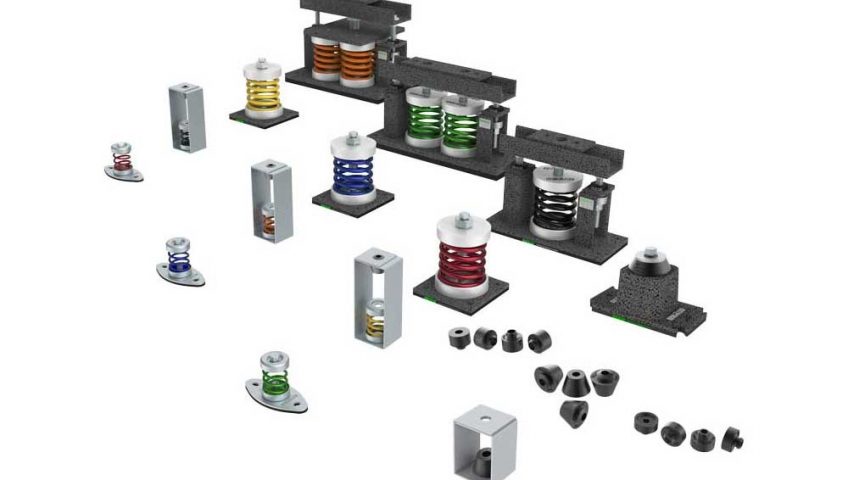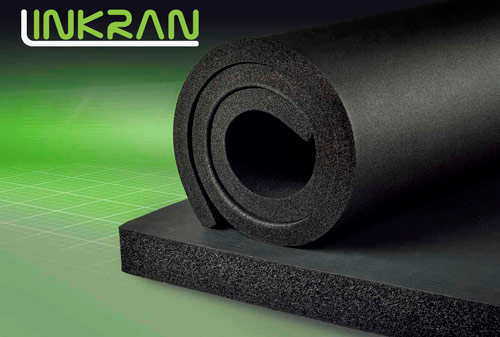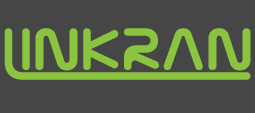Elastomeric tubular insulation: For indoor thermal systems
Protect black and protect silver tubular insulation for indoor thermal systems and proper resistance against mechanical strokes
Aluminum coated tubular insulation in three types of 130, 230 and 400 micron: for outdoor thermal systems and resistance against UV ray
LINKRAN elastomeric foam tubular insulation produces up to 4 inch with thicknesses of 6, 9, 13, 16, 19, 25, 32, 40 and 50.Tubular insulation is suitable for steel, copper and multi-layer pipes in different categories

Vibration Isolator
Today, most modern buildings are equipped with mechanical devices such as air conditioners. This mechanical equipment creates vibrations, shocks and noise
The purpose of using mechanical shock absorption is to reduce the transmission of vibration and noise caused by mechanical equipment to the building structure
Implementing Roll-bolt, the first step in every support system implementation
Implementing Roll-bolt, the first step in every support system implementation
Roll-bolt - Anchor bolt
Implementing roll-bolt is the first step in implementing every support system that at the same time, it requires high technical skills. The least mistake in installing the bolt roll will cause irreparable damage.
Roll-bolts divide into two categories:
- Mechanical
- Chemical
Here is a brief explanation about mechanical roll- bolts:
The first step in selecting roll-bolt is type of the ceiling and the concrete class in which the roll bolt is supposed to be installed
Next, the amount of force (tension and shear) that this roll bolt is supposed to tolerate must be considered by the designer.
Tolerating the seismic loads is another point that is considered by some designers.
In addition, the resistance of the roll-bolt against fire is another parameter in choosing the roll-bolt.
Special attention should be paid to the following points when designing and installing the roll-bolt:
- Installing distance of two roll-bolts from each other
- Installing distance of roll-bolt from edge of the concrete
- Required torque for roll-bolt activation
- Planting depth of the roll-bolt
Beam Clamps
Beam clamps
Beam clamps
Beam clamps are components that are applied for installing electrical and mechanical equipment and installations such as air ducts, water, gas, sewage and fire pipes, as well as cable trays to main and side metal beams, without the need for drilling and welding and make repairing and maintenance operation of the equipment easy in the future.
The above mentioned equipment can be permanently or temporarily connected the channels and pipes under floor or ceiling to the edge of the beams. They can also act as joint between the beams and tolerate vertical and horizontal loads simultaneously.
They are also easier and faster than welding and drilling methods and do not requiring any special equipment and are analyzed by engineers.
Beam clamps are usually used in buildings under construction, factories and warehouses for connecting the carrier beams and other beams.
Beam clamps have an adjustable mounting with an adjusting screw that allows the installation on a variety of beams with different thicknesses and can be easily closed by hand and need to be tighten about one round (depending on the specifications of the screw and it related torque) with tools so that to be installed safely on the beams. Adjustable screws also have a backing nut to prevent loosening.
Most of beam clamps are made for connecting specified equipment in different sizes and thicknesses and have different applications. This variety of sizes and designs helps restrain equipment on different types of beams.
Beam clamps are mostly made of cast iron, stainless steel and steel. To increase their durability, they are electroplated or electro galvanized depending on the need, so that they can be easily used in areas where there is a possibility of corrosion and rust
Beam clamps can also tolerate a variety of loads, which can be selected by consulting with the company's experts regarding the expense, size, tolerating the maximum load together with faster installation and engineering designing.
As a producer in the Department of Mechanical and Electrical installations , we are delighted to bring our national products at the right price and the quality of the world .
FANTAP Co. offers a variety of installation support, including galvanized steel profiles , beam clamps , pipe clamps , air duct flange systems and mechanical vibration isolators with LINKRAN brand across the country
Insulation Operation
INSULATION OPERATION - Installation LINKRAN Insulation
| عملیات عایق کاری - نصب عایق | Installing Insulation |
| حداکثر عملکرد حرارتی یا مقدار R (میزان مقاومت در برابر انتقال حرارت) عایق به نصب مناسب بستگی دارد. | The maximum thermal performance or R-value of insulation is very dependent on proper installation. |
| جدول زیر به معرفی نمای کلی بیشتر مواد موجود برای عایق کاری، محل نصب و مزایای آنها میپردازد. | The table below provides an overview of most available insulation materials, how they are installed, where they're typically installed, and their advantages. |

| ADVANTAGES | WHERE APPLICABLE | MATERIAL | TYPE |
| High insulating value for relatively little thickness.
Can block thermal short circuits when installed continuously over frames or joists. |
Unfinished walls, including foundation walls
Floors and ceilings
Unvented low-slope roofs |
Polystyrene
Polyisocyanurate
Polyurethane |
Foam board or rigid foam |
| Can withstand high temperatures. | Ducts in unconditioned spaces
Other places requiring insulation that can withstand high temperatures |
Fiberglass
Mineral (rock or slag) wool |
Rigid fibrous or fiber insulation |
| نوع | ماده | محل نصب | مزایا |
| عایق پنلی فومی یا فوم سفت | پلی استایرن
پلی ایزوسیانورات
پلی یورتان |
سطوح ناتمام شامل دیوارههای پایه، زمینها و سقفهای شیبدار بدون دریچه | حجم عایق بالا برای ضخامت نسبتا کم.
می تواند به طور مداوم مدارهای کوتاه حرارتی را هنگام نصب روی فریمها یا تیرچه ها مسدود کند. |
| عایق فیبری سفت یا عایق فیبری | پشم شیشه
پشم معدنی (سنگ یا سرباره) |
مجاری در فضاهای پیش بینی نشده
سایر مکان هایی که به عایق کاری نیاز دارند و مقاوم به درجه حرارت بالا هستند. |
تحمل در برابر حرارت بالا |
| عایق پنلی فومی یا فوم سفت
میتوان عایق پنلی فومی فوم را برای عایق کردن تقریبا هر قسمت از ساختمان از پشت بام تا پایه به کار برد. این عایقها برای پوشش دیوارههای بیرونی، پوشش داخلی دیوارههای زیرزمین و همچنین کاربردهای ویژه مانند دریچههای زیر شیروانی بسیار مؤثر هستند. مقاومت حرارتی این عایقها بسیار خوب بوده (تا حدود 2 برابر بیشتر از سایر مواد عایق با ضخامت یکسان)، و هدایت گرما از طریق عناصر سازه مانند میخهای چوبی و فولادی را کاهش می دهند. متداولترین مواد برای ساخت عایقهای پنلی پلیاستایرن، پلی ایزوسیانورات (پلیزو) و پلی اورتان میباشند. |
Foam Board or Rigid Foam
Foam boards -- rigid panels of insulation -- can be used to insulate almost any part of your home, from the roof down to the foundation. They are very effective in exterior wall sheathing, interior sheathing for basement walls, and special applications such as attic hatches. They provide good thermal resistance (up to 2 times greater than most other insulating materials of the same thickness), and reduce heat conduction through structural elements, like wood and steel studs. The most common types of materials used in making foam board include polystyrene, polyisocyanurate (polyiso), and polyurethane. |
| عایق پنلی فیبری سفت
عایق فیبری سفت یا عایق پنلی فیبری شامل مواد پشم شیشه و همچنین مواد پشم معدنی بوده و در درجه اول برای عایقکاری مجرای هوا در خانه ها استفاده می شود. در صورت نیاز به عایق کاری با میزان مقاومت حرارتی بالا نیزبه کار برده میشود. این محصولات در ضخامتهای مختلف از 1 اینچ تا5/2 اینچ موجود هستند. |
Rigid Fiber Board Insulation
Rigid fiber or fibrous board insulation consists of either fiberglass or mineral wool material and is primarily used for insulating air ducts in homes. It is also used when there's a need for insulation that can withstand high temperatures. These products come in a range of thicknesses from 1 inch to 2.5 inches. They can also use special weld pins with integral-cupped head washers |
| انواع عایق فومی
امروزه ، اکثرعایقهای فومی از مواد مضر برای لایه ازن مانند کلروفلوئوروکربن ها (CFC) یا هیدروکلرول فلوئوروکربن ها (HCFC) استفاده نمیکنند. دو نوع عایق فومی وجود دارد: سلول بسته و سلول باز. معمولا هر دواز پلی اورتان ساخته میشوند. در فوم سلول بسته، سلولهای با چگالی بالا بسته شده و پر از گاز میشوند. این کار به انبساط فوم کمک کرده تا فضاهای اطراف خود را پر کند. سلولهای فوم سلول باز چگالی بالایی ندارند و از هوا پر میشوند، به این صورت بافت عایق اسفنجی میشود انتخاب نوع عایق به نحوه استفاده و بودجه شما بستگی دارد. در حالی که مقدار مقاومت حرارتی فوم سلول بسته بیشتر است و همچنین مقاومت بیشتری در برابر رطوبت و نشت هوا دارد، مواد نیز متراکمتر بوده و هزینه نصب آن گرانتر است. فوم سلول باز سبکتر و کم هزینهتر است. نباید زیر سطحی که احتمال جذب آب در آن وجود دارد استفاده شود. برای انتخاب بهترین نوع عایق، با یک متخصص حرفهای مشورت کنید.
مواد موجود عایق فومی به شرح ذیل هستند:
سمنتی (سیمانی) فنلیک پلی ایزوسیانورات (پلیزو) پلی یورتان
|
Types of Foam Insulation
Today, most foam materials use foaming agents that don't use chlorofluorocarbons (CFCs) or hydrochlorofluorocarbons (HCFCs), which are harmful to the earth's ozone layer.
There are two types of foam-in-place insulation: closed-cell and open-cell. Both are typically made with polyurethane. With closed-cell foam, the high-density cells are closed and filled with a gas that helps the foam expand to fill the spaces around it. Open-cell foam cells are not as dense and are filled with air, which gives the insulation a spongy texture.
The type of insulation you should choose depends on how you will use it and on your budget. While closed-cell foam has a greater R-value and provides stronger resistance against moisture and air leakage, the material is also much denser and is more expensive to install. Open-cell foam is lighter and less expensive but should not be used below ground level where it could absorb water. Consult a professional insulation installer to decide what type of insulation is best for you.
Available foam insulation materials include:
Cementitious Phenolic Polyisocyanurate (polyiso) Polyurethane.
|
In case of being interested in studying about elastomeric insullation , it has been researched professionaly by LINKRAN.


